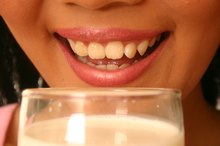Signs & Symptoms of Low Vitamin D in Teens
Despite the fact that vitamin D is readily available, 58 million American children don’t get enough of this vital vitamin. The vitamin helps your body process calcium, which helps your bones develop and stay strong so it’s essential for teenagers whose bodies are still growing. Vitamin D is found in milk and milk products as well as in some types of fish and cereals. Exposure to sun also causes your body to produce the vitamin.
Rickets
Rickets is a condition that occurs in adolescents who have been vitamin D-deficient for years. A teenager with rickets will be smaller than average and may show some bone abnormalities. In particular, she may have bowed legs, thick wrists or a curved spine. A doctor needs to perform x-rays and take blood tests to diagnose rickets. This condition can often be treated by adding more vitamin D to the teen’s diet, although in some cases surgery may be necessary.
- Rickets is a condition that occurs in adolescents who have been vitamin D-deficient for years.
- A teenager with rickets will be smaller than average and may show some bone abnormalities.
Bone Breaks and Pain
Diet for Rickets
Learn More
Even if her bones are of normal size, a vitamin D-deficient teenager’s bones may be weakened because she’s not getting enough calcium to keep her bones strong. Vitamin D deficiency may be to blame if she’s broken any bones easily, such as in a mild accident. She may also be able to feel pain in her bones due to her deficiency. Any bones can be affected. Eating more of the vitamin will generally strengthen her bones without additional medical help.
- Even if her bones are of normal size, a vitamin D-deficient teenager’s bones may be weakened because she’s not getting enough calcium to keep her bones strong.
- Eating more of the vitamin will generally strengthen her bones without additional medical help.
Obesity
With nearly one third of American teenagers overweight, it can be difficult to determine if your teen is overweight because of vitamin D deficiency, but the two have been linked. A study done by Johns Hopkins University found that teens who had low vitamin D levels were five times more like to be obese than their peers. It’s unknown exactly why the two are linked, but helping your child get active while feeding her more low-fat, vitamin-D rich foods can raise her levels while lowering her weight.
Fatigue and Depression
Safety of Taking B12 While Nursing
Learn More
Depression is common among teenagers, and while vitamin D deficiency won’t cause your teenager to be depressed, it can make her symptoms worse. The deficiency can cause her to be fatigued, making her less active and more withdrawn. Since sun exposure creates vitamin D, teens who live in overcast, cold locales where they don’t see the sun much may experience more fatigue and depression during cloudy months. If you notice she’s especially withdrawn in winter, taking her outside for walks whenever the sun appears may help.
- Depression is common among teenagers, and while vitamin D deficiency won’t cause your teenager to be depressed, it can make her symptoms worse.
Related Articles
References
- Linus Pauling Institute: Vitamin D
- Vitamin D Council: Correcting Vitamin D Deficiency in Obese Adolescents
- University of Maryland Medical Center: Rickets
- Office of Dietary Supplements: Dietary Supplement Fact Sheet: Vitamin D
- Vitamin D Council: Depression
- Institute of Medicine (US) Committee to Review Dietary Reference Intakes for Vitamin D and Calcium; Ross AC, Taylor CL, Yaktine AL, et al., editors. Dietary Reference Intakes for Calcium and Vitamin D. Washington (DC): National Academies Press (US); 2011. 3, Overview of Vitamin D.
- Roy S, Sherman A, Monari-Sparks MJ, Schweiker O, Hunter K. Correction of low vitamin D improves fatigue: Effect of correction of low Vitamin D in fatigue study (EViDiF study). N Am J Med Sci. 2014 Aug;6(8):396-402. doi: 10.4103/1947-2714.139291
- Wong SK, Chin KY, Ima-Nirwana S. Vitamin D and Depression: The evidence from an indirect clue to treatment strategy. Curr Drug Targets. 2018;19(8):888-97. doi: 10.2174/1389450118666170913161030
- Nair R, Maseeh A. Vitamin D: The "sunshine" vitamin. J Pharmacol Pharmacother. 2012;3(2):118-26. doi:10.4103/0976-500X.95506
- Meena N, Singh Chawla SP, Garg R, Batta A, Kaur S. Assessment of vitamin D in rheumatoid arthritis and its correlation with disease activity. J Nat Sci Biol Med. 2018;9(1):54-58. doi:10.4103/jnsbm.JNSBM_128_17
- Fares A. Winter cardiovascular diseases phenomenon. N Am J Med Sci. 2013;5(4):266-79. doi:10.4103/1947-2714.110430
- Porojnicu AC, Dahlback A, Moan J. Sun exposure and cancer survival in Norway: changes in the risk of death with season of diagnosis and latitude. Adv Exp Med Biol. 2008;624:43-54. doi: 10.1007/978-0-387-77574-6_4
- Holick MF et al. Evaluation, treatment, and prevention of vitamin D deficiency: an Endocrine Society clinical practice guideline. J Clin Endocrinol Metab. 2011 Jul;96(7):1911-30. doi: 10.1210/jc.2011-0385
- Ross AC et al. The 2011 report on dietary reference intakes for calcium and vitamin D from the Institute of Medicine: what clinicians need to know. J Clin Endocrinol Metab. 2011 Jan;96(1):53-8.
- Pilz et al. Vitamin D testing and treatment: a narrative review of current evidence. Endocr Connect. 2019 Feb 1;8(2):R27-R43. doi: 10.1530/EC-18-0432
- National Institutes of Health Offices of Dietary Supplements. Vitamin D fact sheet. Updated August 7, 2019.
Writer Bio
Cooking, travel and parenting are three of Kathryn Walsh's passions. She makes chicken nuggets during days nannying, whips up vegetarian feasts at night and road trips on weekends. Her work has appeared to The Syracuse Post-Standard and insider magazine. Walsh received a master's degree in journalism from Syracuse University.









